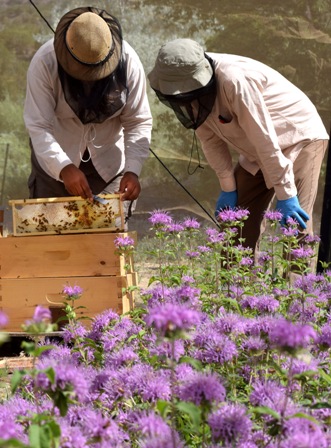 New Mexico State University's College of Agricultural, Consumer and Environmental Sciences is researching the medicinal benefits of oregano for bees and if the benefits are transferred to humans through honey. Beekeeper Melanie Kirby of Zia Queen Bees and NMSU senior research specialist Robert Heyduck are taking a honey sample to be tested for medicinal compounds.
New Mexico State University's College of Agricultural, Consumer and Environmental Sciences is researching the medicinal benefits of oregano for bees and if the benefits are transferred to humans through honey. Beekeeper Melanie Kirby of Zia Queen Bees and NMSU senior research specialist Robert Heyduck are taking a honey sample to be tested for medicinal compounds.
(NMSU photo by Jane Moorman)WRITER: Jane Moorman, 505-249-0527, jmoorman@nmsu.edu
CONTACT: Robert Heyduck, 505-852-4241, rheyduck@nmsu.edu
ALCALDE – An oregano farmer, a beekeeper and a researcher with New Mexico State University are investigating the medicinal benefits of oregano for bees and whether these benefits are transferred to humans through honey.
"Our goal is to examine and promote Monarda fistulosa as a new crop or accessory planting to affect bee health and also produce a hive product and field crop that can be processed in a number of ways," said Rob Heyduck, senior research specialist at NMSU's College of Agricultural, Consumer and Environmental Sciences' Sustainable Agriculture Center at Alcalde.
Monarda fistulosa, a member of the mint plant family commonly called wild bergamot or bee balm, is known as Oregano de las Sierra for its oregano flavor.
"There are 60 plants that produce the flavor of oregano," said Embudo farmer Todd Bates, who is cultivating the plant normally found wild in the mountains. "The flavor comes from the chemical compounds that also give the plant its medicinal qualities."
It is those medicinal qualities that Zia Queen Bees owner Melanie Kirby is interested in.
"Bee health is of critical importance in pollinator productivity," Kirby said. "As a beekeeper, pollinator productivity is becoming more and more challenging due to weather fluctuation, increase in pest and disease issues, compromising habitats and management practices."
After placing beehives in Bates' field for a couple of years, Kirby thinks there are possible health benefits from the bees feeding on the Monarda flowers.
Bates and Kirby approached NMSU researcher Heyduck to conduct a study. NMSU's College of ACES received a U.S. Department of Agriculture specialty crop block grant to finance the study.
"To analyze Oregano de la Sierra and its effects on bee health, and potential human health benefits through value-added products, we are coordinating with several additional institutions and laboratories both in-state and through the USDA Agricultural Research Service," Heyduck said.
The study is located on a site in the northern Rio Grande Valley and Sangre de Cristo mountain range. Nucleus honeybee colonies established by Zia Queen Bee are located at the three sites.
"We are collecting nectar directly from the flowers and bee-gathered nectar, as well as honey from the hives," Kirby said. "We are also gathering pollen from the hives."
The collections are scheduled for pre-flowering, middle of flowering and after flowering.
Don Hyder and Eric Miller, professors of biology and chemistry, respectively, at San Juan College in Farmington, are using gas chromatography to analyze the nectar and honey samples to determine chemical compounds.
"These compounds, including carvacrol, thymol, p-cymene, have shown bactericidal, viricidal and miticidal activity in previous research," said Heyduck. "We are hoping the analysis will show that these medicinal compounds are in the honey."
"Among herbalists, oregano has provided relief from respiratory and digestive symptoms," Bates said. "It would be wonderful if these properties were also gained from the honey."
Kirby and Heyduck are also collecting bees for analysis of their health.
"By feeding bees in isolation and free-choice, we are seeking to determine a potential bee preference and evaluate the parasite loads of bees fed different diets," Heyduck said. "We are sending the live bees to Jay Evans at the USDA-ARS Bee Research Laboratory in Beltsville, Maryland, to have the bees analyzed for specific viruses and diseases."
Bees preserved in saline solution are being sent to the Bee Information Partnership, a nation-wide beehive health database.
"We are adding our findings to that database to have records of these exact hives as they progress," Heyduck said. "Population samples of Varroa mite, a parasite threatening honeybees worldwide, will be taken at multiple times from the project hives and will serve as an indicator of oregano's effect on bee health."
Regarding the outcome of the research, Heyduck said, "Todd works with oregano as an herb you can add to food. We hope that this research will bring about natural value-added products. Also using the Oregano de la Sierra plant in revegetation mixes, habitat enhancement, and pollinator gardens could add something medicinal for the pollinators in the area."


